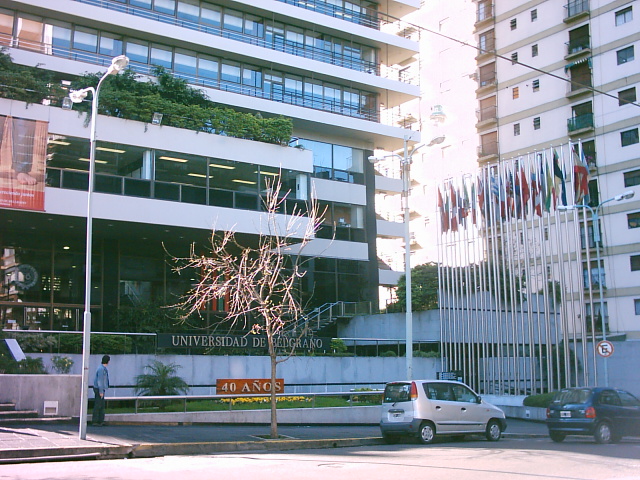|
Argentinians
Argentines (mistakenly translated Argentineans in the past; in Spanish (masculine) or (feminine)) are people identified with the country of Argentina. This connection may be residential, legal, historical or cultural. For most Argentines, several (or all) of these connections exist and are collectively the source of their being ''Argentine''. Argentina is a multiethnic and multilingual society, home to people of various ethnic, religious, and national origins, with the majority of the population made up of Old World immigrants and their descendants. As a result, Argentines do not equate their nationality with ethnicity, but with citizenship and allegiance to Argentina. Aside from the indigenous population, nearly all Argentines or their ancestors immigrated within the past five centuries. Among countries in the world that have received the most immigrants in modern history, Argentina, with 6.6 million, ranks second to the United States (27 million), and ahead of other immigr ... [...More Info...] [...Related Items...] OR: [Wikipedia] [Google] [Baidu] |
Argentina
Argentina (), officially the Argentine Republic ( es, link=no, República Argentina), is a country in the southern half of South America. Argentina covers an area of , making it the second-largest country in South America after Brazil, the fourth-largest country in the Americas, and the eighth-largest country in the world. It shares the bulk of the Southern Cone with Chile to the west, and is also bordered by Bolivia and Paraguay to the north, Brazil to the northeast, Uruguay and the South Atlantic Ocean to the east, and the Drake Passage to the south. Argentina is a federal state subdivided into twenty-three provinces, and one autonomous city, which is the federal capital and largest city of the nation, Buenos Aires. The provinces and the capital have their own constitutions, but exist under a federal system. Argentina claims sovereignty over the Falkland Islands, South Georgia and the South Sandwich Islands, and a part of Antarctica. The earliest recorded human prese ... [...More Info...] [...Related Items...] OR: [Wikipedia] [Google] [Baidu] |
Rioplatense Spanish
Rioplatense Spanish (), also known as Rioplatense Castilian, is a variety of Spanish spoken mainly in and around the Río de la Plata Basin of Argentina and Uruguay. It is also referred to as River Plate Spanish or Argentine Spanish. It is the most prominent dialect to employ ''voseo'' in both speech and writing. Many features of Rioplatense are also shared with the varieties spoken in south and eastern Bolivia, and Paraguay. This dialect is often spoken with an intonation resembling that of the Neapolitan language of Southern Italy, but there are exceptions. As Rioplatense is considered a dialect of Spanish and not a distinct language, there are no credible figures for a total number of speakers. The total population of these areas would amount to some 25–30 million, depending on the definition and expanse. Location Rioplatense is mainly based in the cities of Buenos Aires, Rosario, Santa Fe, La Plata, Mar del Plata and Bahía Blanca in Argentina, the most populated citi ... [...More Info...] [...Related Items...] OR: [Wikipedia] [Google] [Baidu] |
Flag Of Argentina
The national flag of the Argentine Republic is a triband (flag), triband, composed of three equally wide horizontal bands coloured light blue and white. There are multiple interpretations on the reasons for those colors. The flag was created by Manuel Belgrano, in line with the creation of the Cockade of Argentina, and was first raised at the city of Rosario on February 27, 1812, during the Argentine War of Independence. The National Flag Memorial was later built on the site. The First Triumvirate (Argentina), First Triumvirate did not approve the use of the flag, but the Asamblea del Año XIII allowed the use of the flag as a war flag. It was the Congress of Tucumán which finally designated it as the national flag, in 1816. A yellow Sun of May was added to the center in 1818. The full flag featuring the sun is called the Official Ceremonial Flag (). The flag without the sun is considered the Ornamental Flag (). While both versions are equally considered the national flag, the ... [...More Info...] [...Related Items...] OR: [Wikipedia] [Google] [Baidu] |
Old World
The "Old World" is a term for Afro-Eurasia that originated in Europe , after Europeans became aware of the existence of the Americas. It is used to contrast the continents of Africa, Europe, and Asia, which were previously thought of by their inhabitants as comprising the entire world, with the "New World", a term for the newly encountered lands of the Western Hemisphere, particularly the Americas. Etymology In the context of archaeology and world history, the term "Old World" includes those parts of the world which were in (indirect) cultural contact from the Bronze Age onwards, resulting in the parallel development of the early civilizations, mostly in the temperate zone between roughly the 45th and 25th parallels north, in the area of the Mediterranean, including North Africa. It also included Mesopotamia, the Persian plateau, the Indian subcontinent, China, and parts of Sub-Saharan Africa. These regions were connected via the Silk Road trade route, and they have a p ... [...More Info...] [...Related Items...] OR: [Wikipedia] [Google] [Baidu] |
Great European Immigration Wave To Argentina
The great European immigration wave to Argentina took place in the late 19th and early 20th century. It consisted mostly of Italian and Spanish immigrants, along with other nationalities such as French, Slavs (especially Ukrainians, Poles, Russians and Croatians), Germans (many of whom were registered with other nationalities upon arrival in the country, for example as Russians, since most of them were ethnic Germans from different parts of Europe)Swedish, Danish and Welsh, among others, including Jews. During this period Argentina saw a huge increase in population. Some groups of European immigrants modified the politics of Argentina by introducing political movements from their source countries, such as labor unionism, anarchism and socialism. Causes Before the immigration, Argentina was sparsely populated. The Spanish colonization of the Americas favored Mexico and Peru, the southern Spanish regions had no sources of wealth and had lower populations. This population ... [...More Info...] [...Related Items...] OR: [Wikipedia] [Google] [Baidu] |
Indigenous Peoples Of South America
The Indigenous peoples of South America or South American Indigenous peoples, are the pre-Colombian peoples of South America and their descendants. These peoples contrast with South Americans of European ancestry and those of African descent. In Spanish, Indigenous people are often referred to as ''indígenas'' or ''pueblos indígenas'' (lit. Indigenous peoples). They may also be called ''pueblos nativos'' or ''nativos'' (lit. Native peoples). The term ''aborigen'' (lit. aborigine) is used in Argentina and ''pueblos aborígenes'' (lit. aboriginal peoples) is commonly used in Colombia. The English term "Amerindian" (short for "Indians of the Americas") is often used in the Guianas. Latin Americans of mixed European and Indigenous descent are usually referred to as mestizos (Spanish) and mestiços (Portuguese). While those of mixed African and Indigenous ancestry are referred to as zambos. It is believed that the first human populations of South America either arrived from Asia ... [...More Info...] [...Related Items...] OR: [Wikipedia] [Google] [Baidu] |
Near East
The ''Near East''; he, המזרח הקרוב; arc, ܕܢܚܐ ܩܪܒ; fa, خاور نزدیک, Xāvar-e nazdik; tr, Yakın Doğu is a geographical term which roughly encompasses a transcontinental region in Western Asia, that was once the historical Fertile Crescent, and later the Levant region. It also comprises Turkey (both Anatolia and East Thrace) and Egypt (mostly located in North Africa, with the Sinai Peninsula being in Asia). Despite having varying definitions within different academic circles, the term was originally applied to the maximum extent of the Ottoman Empire. According to the National Geographic Society, the terms ''Near East'' and ''Middle East'' denote the same territories and are "generally accepted as comprising the countries of the Arabian Peninsula, Cyprus, Egypt, Iraq, Iran, Israel, Jordan, Lebanon, Palestinian territories, Syria, and Turkey". In 1997, the Food and Agriculture Organization of the United Nations, Food and Agriculture Organization (FAO) ... [...More Info...] [...Related Items...] OR: [Wikipedia] [Google] [Baidu] |
Universidad De Belgrano
The University of Belgrano ( es, Universidad de Belgrano, commonly referred to as UB) is a private university established in 1964 and located in the Belgrano district of the city of Buenos Aires, Argentina. Overview The university has nine departments: * Architecture and Urban Planning * Law and Political Science * Economics * Humanities * Engineering and Computer Technology * Agricultural Sciences * Language and Foreign Studies * Health Sciences * Applied Sciences The school operates 90.9 FM, a station featuring eclectic programming and daily BBC News broadcasts. The school offers an international program called The Argentine and Latin American Studies Program (PEAL) which is a five-week term consisting of two courses in Spanish at intermediate and advanced level, and four upper division survey courses in Latin American Studies at the 300 level. Ranking According to the QS World University Rankings, ''UB'' is the seventh best private university in the country and is ran ... [...More Info...] [...Related Items...] OR: [Wikipedia] [Google] [Baidu] |
José Luis Romero (historiador)
José Luis Romero may refer to: * José Luis Romero (footballer) (born 1945), Spanish footballer * José Luis Romero (journalist) (1967-2009), Mexican journalist {{hndis, Romero, José Luis ... [...More Info...] [...Related Items...] OR: [Wikipedia] [Google] [Baidu] |
Darcy Ribeiro
Darcy Ribeiro (October 26, 1922 – February 17, 1997) was a Brazilian anthropologist, historian, sociologist, author and politician. His ideas have influenced several scholars of Brazilian and Latin American studies. As Minister of Education of Brazil he carried out profound reforms which led him to be invited to participate in university reforms in Chile, Peru, Venezuela, Mexico and Uruguay after leaving Brazil due to the 1964 coup d'état.Ocampo Lopéz, JavierDarcy Ribeiro. 2006. Biography Darcy Ribeiro was born in Montes Claros, in the state of Minas Gerais, the son of Reginaldo Ribeiro dos Santos and of Josefina Augusta da Silveira. He completed his primary and secondary education in his native town, at the Grupo Escolar Gonçalves Chaves and at the Ginásio Episcopal de Montes Claros. He is best known for development work in the areas of education, sociology and anthropology and for being, along with his friend and colleague Anísio Teixeira, one of the founders of t ... [...More Info...] [...Related Items...] OR: [Wikipedia] [Google] [Baidu] |
Universidad De Buenos Aires
The University of Buenos Aires ( es, Universidad de Buenos Aires, UBA) is a public research university in Buenos Aires, Argentina. Established in 1821, it is the premier institution of higher learning in the country and one of the most prestigious universities of Ibero-America. It has educated 17 Argentine presidents, produced four of the country's five Nobel Prize laureates, and is responsible for approximately 40% of the country's research output. The ''QS World University Rankings'' currently places the UBA at number 67, the highest ranking university in the Spanish-speaking world. The university's academic strength and regional leadership make it attractive to many international students, especially at the postgraduate level. Just over 4 percent of undergraduates are foreigners, while 15 percent of postgraduate students come from abroad. The Faculty of Economic Sciences has the highest rate of international postgraduate students at 30 percent, in line with its reputation a ... [...More Info...] [...Related Items...] OR: [Wikipedia] [Google] [Baidu] |





